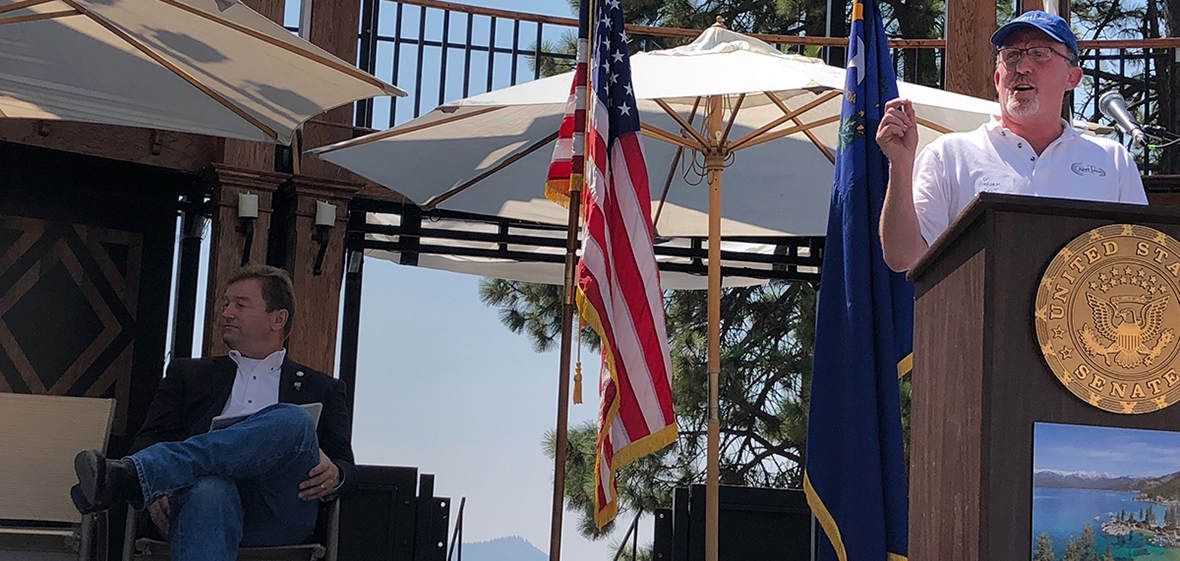Funding for upgrades and new cameras for the 26-camera AlertTahoe network, which tracked more than 100 fires for firefighters in 2017, was announced today by the University of Nevada, Reno's Nevada Seismological Lab Director Graham Kent in a presentation at the annual Lake Tahoe Summit.
"Much needed upgrades and two additional cameras are now possible with a recent grant of $226,000 from the U.S. Forest Service and another $42,500 from the Parasol Tahoe Community Foundation - with an added $55,000 endowment in matching funds for ongoing maintenance," Kent said during his presentation to the Tahoe Summit audience, which included senators, congressmen, governors and federal, state and local public agency officials who all represent Lake Tahoe - both in Nevada and California.
The camera network helps to detect and monitor wildfires in and around the Lake Tahoe Basin. The real-time camera fire-detection system is helping to protect the communities, forests and water quality and clarity at Lake Tahoe. Fires can be tracked from cell phones, tablets or desktops on www.alertwildfire.org.
"Over 1.2 million acres of land were devastated by wildfires in Nevada last year alone, and as Nevada's firefighters and the Bureau of Land Management continue to battle deadly blazes across Nevada, I'm fighting to make sure we have the necessary resources to detect and prevent future fires," U.S. Senator Dean Heller said in a prepared statement. "I welcome the Department of Agriculture's $226,000 to support the AlertTahoe Fire Monitoring and Early Detection Warning System, which has helped stop hundreds of potentially devastating fires over the past few years."
Thanks to Heller's efforts, in a package of spending bills approved by the U.S. Senate Aug. 1, a $12 million spending bill qualified AlertTahoe system for additional federal wildfire funding to help cover the implementation of four new cameras and upgrade 13 existing cameras in the Basin to better connect to the emergency response network.
"We must continue funding scientists and researchers like Graham Kent doing work here Lake Tahoe," U.S. Senator Catherine Cortez Masto told the Tahoe Summit crowd in her remarks. "Thank you for helping us better understand and keep this region safe."
Tahoe Prosperity Center
Two new mountaintop cameras will be made possible by the Parasol Tahoe Community Foundation funding as well as the endowment that helps the University of Nevada, Reno with ongoing funds for maintenance and upgrades. The Tahoe Prosperity Center secured the funding agreement.
"The AlertTahoe camera system is successful due to the private/public partnership with the Tahoe Prosperity Center, our partner organization for fundraising for the camera equipment," Kent said. "They spearheaded these critical fundraising efforts that ensure that these fire prevention cameras are funded by local businesses, organizations and other partners to keep our communities safe from wildfire."
While firefighters work hard to put out the fires, the cameras give them intel immediately, improving the chances of putting out the fires more quickly, Kent said.
"Despite Artificial Intelligence-Machine vision and a nifty lightning interface we're testing, the greatest value is in response to 911 calls," he said. "Dispatch can know immediately, in 20 seconds, what the fire situation looks like, and fire managers can scale up or down without delays for guessing or waiting for spotter planes or helicopters for immediate knowledge."
The Lake Tahoe Summit was hosted this year by Heller and held at Sand Harbor State Park on the shores of Lake Tahoe, just south of Incline Village, Nevada.
Today's smoky air in the Basin served as a reminder how close the wildfires are to the area, Kent said. The AlertTahoe system started here in Lake Tahoe and is now being replicated throughout the West in southern California, Oregon and Sonoma County in northern California - known as AlertWildfire.
"While we all know that what happens in Vegas stays in Vegas, what happens in Tahoe changes the world," Kent said. "These cameras are just one added tool for firefighters. And the coordination and collaboration of agencies, the public and private partnerships and the communication has improved since the system was first put in place. Other communities and fire managers around the country have noticed."
The AlertWildfire mountaintop camera network tracked 240 western wildfires in 2017. At Lake Tahoe, the system has been used successfully by firefighting managers for four fire seasons for early detection, to spot and track fires and for quicker, cheaper and more tactical response and suppression.
The system also played a critical role for early detection during an arson outbreak in late 2016 at South Lake Tahoe with some 30 fires in a 60-day period both in the City of South Lake Tahoe and the surrounding forests.
State-of-the-art cameras and communications network
One camera can see 5,000 square miles during the day; and from 11,000 square miles to 20,000 square miles at night using its near-infrared capabilities (on unobstructed view sheds).
The fire-camera system is built on the backbone of the University of Nevada, Reno's Seismological Lab's earthquake monitoring communications network based in the College of Science. It features private high-speed internet connectivity capable of transmitting seismic, environmental and climate data, in addition to the live-streaming high-definition video from the fire cameras.
Fire managers can manually rotate, tilt, pan and zoom the cameras. While fire agencies can move the cameras with this active pan-tilt-zoom functionality, the public can observe the real-time views, as well as the time-lapse functions with a 15-minute, 60-minute and 6-hour time-lapse utility built into the webpage viewer (right-click on the camera image for options). The Seismological Lab's YouTube channel, nvseismolab, has a library of videos captured from the networkThe Seismological Lab's YouTube channel, nvseismolab, has a library of videos captured from the network, such as this one: Perry Fire sets the stage for an apocalyptic near miss as Virginia Peak burns over
.












